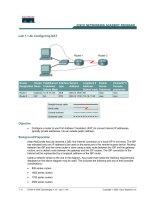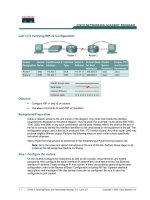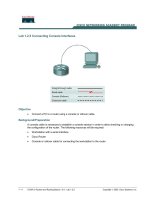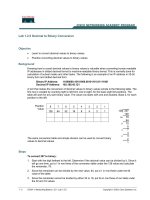Tài liệu Lab 1.2.8 Hexadecimal Conversions docx
Bạn đang xem bản rút gọn của tài liệu. Xem và tải ngay bản đầy đủ của tài liệu tại đây (77.61 KB, 4 trang )
1 - 4 CCNA 1: Networking Basics v 3.0 - Lab 1.2.8 Copyright 2003, Cisco Systems, Inc.
Lab 1.2.8 Hexadecimal Conversions
Objective
• Learn the process to convert hexadecimal values to decimal and binary values.
• Learn the process to convert decimal and binary values to hexadecimal values.
• Practice converting between decimal, binary and hexadecimal values.
Background / Preparation
The Hexadecimal (Hex) number system is used to refer to the binary
numbers in a NIC or IPv6 address. The word hexadecimal comes from the
Greek word for 16. Hexadecimal is often abbreviated "0x", zero and lower
case x. Hex numbers use 16 unique digits to display any combination of
eight binary digits as only two hexadecimal digits.
A Byte, or 8 bits, can range from 00000000 to 11111111. A Byte can create
256 combinations with decimal values ranging from 0 to 255 or Hex values
0 to FF. Each Hex value represents only four binary bits. The alpha (A-F)
values are not case sensitive.
A tool that makes the conversion of hexadecimal to decimal values simple
is the following table. Use the same techniques as covered in binary to
decimal conversions. The first row is the two Hex positions. The value row
starts as 1 and 16, base 16, for each position to the left.
2 1
16 1
Note: Steps are provided at the end of this lab in the use of the
Windows Scientific Calculator to check the work.
Steps for Hex to decimal conversion
1. Break the Hex value into pairs. Start at the right side. For example 77CE becomes 77 and CE.
Insert a zero in the first position if necessary to complete the first pair.
2. Put each Hex pair in row three. The value in parenthesis is the decimal value of A-F.
3. To get the decimal values in row four, multiply the row two values by row three.
Dec Hex Binar
y
0 0 0000
1 1 0001
2 2 0010
3 3 0011
4 4 0100
5 5 0101
6 6 0110
7 7 0111
8 8 1000
9 9 1001
10 A 1010
11 B 1011
12 C 1100
13 D 1101
14 E 1110
15 F 1111
Position
Value
2 - 4 CCNA 1: Networking Basics v 3.0 - Lab 1.2.8 Copyright 2003, Cisco Systems, Inc.
4. Now just add row four across.
2 1
16 1
77
112 7
2 1
16 1
C
(12)
E
(14)
192 14
Steps for decimal to Hex conversion
1. To be valid for the purpose of this lab, the decimal value will be between 0 and 256. The first
Hex value is derived by dividing the decimal value by 16. If the value is greater than 9 it will need
to be put in Hex form A-F.
2. The second value is the remainder from step 1. If the value is greater than 9 it will need to be put
in Hex form A-F.
3. For example, 209 divided by 16 is 13 with a remainder of 1. 13 equals D in Hex. Therefore, 209
equals D1.
Steps for Hex to binary conversion
1. This is the easiest conversion. Remember that each Hex value converts to four binary bits, so
work right to left.
2. For example, to convert 77CE to binary. Start with E. Use the table at the beginning of this lab to
go directly to binary. The other alternative is to convert the value to decimal, E = 14, and then
use the last four positions of the table used in the decimal to binary conversions.
14 divided by 8 is 1 with a remainder of 6.
6 divided by 4 is 1 with a remainder of 2.
2 divided by 2 is 1 with no remainder.
Add zeros if necessary to end up with four bits.
4321
8421
1110
842
3. Using the same technique, C becomes 1010 and the total so far is 10101110.
4321
8421
1010
82
4.
Position
Value
= 206
Position
Value
= 119
Position
Value
= 14
Position
Value
= 10
3 - 4 CCNA 1: Networking Basics v 3.0 - Lab 1.2.8 Copyright 2003, Cisco Systems, Inc.
5. Using the same technique, the two 7s each become 0111 and the total is 01110111.10101110.
4321
8421
0111
421
Steps for binary to Hex conversion
1. Each Hex value equals four binary bits. Start by breaking the binary value into 4-bit units from
right to left. Add any leading zeros required to end up with all 4-bit values. 01101110. 11101100
would become 0110 1110 1110 1100.
2. Use the table at the beginning of this lab to go directly to Hex. The other alternative is to convert
each 4-bit binary value to decimal, 0-15. Then convert the decimal to Hex, 0-F.
4321
8421
1100
84
4321
8421
1110
842
3. The result is 6E-EC.
Practice
Convert the following values to the other two forms:
Decimal Hex Binary
1 a9
2 FF
3 Bad1
4 E7-63-1C
5 53
6 115
7 19
8 212.65.119.45
9 10101010
Position
Value
= 7
Position
Value
= 12 or C
Position
Value
= 14 or E
4 - 4 CCNA 1: Networking Basics v 3.0 - Lab 1.2.8 Copyright 2003, Cisco Systems, Inc.
10 110
11 11111100.00111100
12 00001100.10000000.11110000.11111111
Checking conversions with the Windows Calculator
It is important to be able to perform the previous calculations manually. However, to check the work
using the Windows Calculator applet, access the Calculator. Click Start > Programs > Accessories
and then Calculator. Click on the View menu to make sure that the calculator is in Scientific mode.
Click on the button for the type of number to be entered, Hex, Dec or Bin. Enter the number in that
form. To convert from one form to another, click on one of the alternate buttons.









